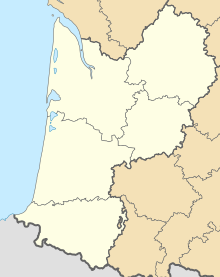| Isturitz and Oxocelhaya caves | |
|---|---|
 Entrance of the Isturitz Cave | |
| Location | Lower Navarre, Pyrénées-Atlantiques |
| Coordinates | 43°21′10″N 1°12′22″W / 43.35278°N 1.20611°W |
| Discovery | 1929 |
The Isturitz and Oxocelhaya caves (French: Grottes d'Isturitz et d'Oxocelhaya) are an important Paleolithic site where a Neanderthal mandible was found, as well as later modern human finds associated with the Aurignacian, Solutrean and Magdalenian. They also include cave paintings and bone flutes.[1] The caves are located in the Gaztelu hill in the Arberoue Valley in the foothills of Pyrenees, in Lower Navarre, a traditional region of the department of Pyrénées-Atlantiques, southwestern France, part of the French Basque Country.[2]
The French government has classified the site as a Monument historique since 1953.[3] Occupation by Neanderthal and Homo sapiens communities extends over a period from 80,000–10,000 years BP, and continued to be use (perhaps only for burials) until the Roman era.[4] The site is discussed within the context of Franco-Cantabrian prehistory, as among the easternmost decorated caves that extended along the Pyrenees and Cantabrian Mountains.[4]
- ^ (in French) Dominique Buisson, Les flûtes paléolithiques d'Isturitz (Pyrénées-Atlantiques), Bulletin de la Société préhistorique française (1990), 420-433
- ^ Name given by the IGN-France.
- ^ Base Mérimée: Classement par les monuments historiques, Ministère français de la Culture. (in French)
- ^ a b Garate, Diego; Labarge, Aude; Rivero, Olivia; Normand, Christian; Darricau, Joëlle (2013). "The Cave of Isturitz (West Pyrenees, France): One Century of Research in Paleolithic Parietal Art". Arts. 2 (4): 253–272. doi:10.3390/arts2040253. ISSN 2076-0752.
